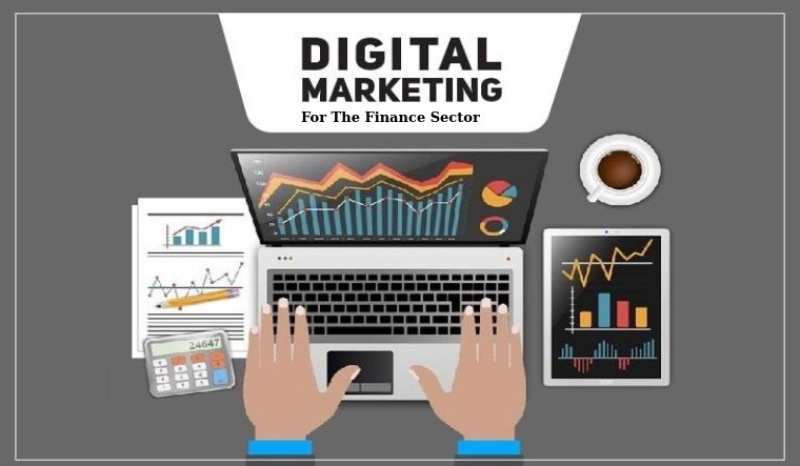Business
Current Trends, Tips, and More in Digital Marketing for Financial Services

Financial institutions are seeing a radical shift in their use of digital marketing. The days of merely using traditional marketing channels, such as direct mail and print advertisements, are long gone. Financial firms are using digital strategies to communicate with their clients more directly and efficiently, and it’s working!
Think about this: 90% of people who apply for loans and mortgages, 85% of people who cash checks, and 76% of people who prepare tax returns begin their search online.
An online search is frequently the first step for customers seeking financial services in determining what kind of assistance they will require, assessing their options, and locating the best provider for their requirements. For financial service providers, having a strong online presence and a successful digital marketing plan can make all the difference.
Let’s explore the significance of digital marketing for financial services, the most recent industry trends, and our best tips for making your plan successful!
Significance of Digital Marketing for Financial Services
Over the past two years, Google reports a 70% increase in mobile searches for the terms “best credit card(s)” and “financial planning and management.” This indicates that more and more customers are deciding to obtain financial advice and purchase financial products online, underscoring the necessity for financial services to improve their digital marketing strategies and capitalize on this trend.
Listed below are some of the key reasons for the importance of digital marketing for financial services:
- Enhanced reach: Digital marketing gives you the ability to reach a global audience of potential customers by extending your reach beyond conventional geographic restrictions.
- Cost efficiency: Digital marketing is a cost-effective option because it frequently offers a higher return on investment (ROI) at a lower cost when compared to traditional marketing channels like print ads or television commercials.
- Targeted advertising: You can use digital marketing to target your ideal clients based on their demographics, interests, and behaviors. This makes sure that your marketing efforts are focused on the people who are most likely to become customers.
- Increased credibility and brand awareness: By being consistently present on digital platforms, you can build credibility and brand awareness and position your business as a reliable leader in the field.
- 24/7 availability: Social media profiles and websites enable users to access information and services whenever they need them, increasing convenience and satisfaction.
Current Trends in Financial Services Digital Marketing
The landscape of financial digital marketing is always changing, offering new channels and platforms for audience targeting, product and service display, and ROI optimization.
Now let’s explore some of the trends and examples that can assist you in customizing your digital marketing strategy for the current market:
- Content marketing
- Social media engagement
- Mobile optimization and app development
- Search engine optimization
- Video Marketing
- Content Marketing
Creating and distributing valuable, relevant content is the foundation of content marketing, which aims to attract and keep a target audience. Content marketing is a tool used in the financial services sector to educate customers, boost trust, and establish thought leadership.
When you consider that by providing valuable and tailored content, you can establish an indirect connection with your audience and present yourself as an open business that is interested in educating them rather than just trying to close deals, content marketing has many advantages.
- Social Media Engagement
Actively engaging and establishing relationships with clients and potential clients on social media sites such as Facebook, Instagram, LinkedIn, X, and others is known as social media engagement. It involves more than just spreading messages; it also entails having deep discussions, answering questions, offering prompt assistance, and promoting a feeling of community.
Social media is a reliable source of information for people, and the financial industry is no different. As a matter of fact, social media is how 70% of financial advisors acquire new clients. This implies that you’ll probably reach more people who are interested in what you have to say if you integrate your content strategy with social media initiatives.
- Mobile Optimization and App Development
Financial institutions must prioritize mobile optimization due to the growing usage of mobile devices. This entails making certain that digital content, apps, and websites are optimized for easy viewing and interaction on tablets and smartphones.
Financial institutions are investing in app development in addition to website optimization to give customers a seamless mobile experience. Since almost 97% of millennials currently use mobile banking, businesses that provide this service have already seen an increase in client engagement.
- Search Engine Optimization
One of the most important tactics for increasing a website’s exposure on search engine results pages is search engine optimization or SEO. When people look for financial solutions online, a solid SEO strategy makes sure that your website appears right at the top and easily grabs their attention.
Local SEO focuses on your city or neighborhood, taking the power of SEO a step further. It’s similar to highlighting your company in the neighborhood. In the context of finance, local SEO refers to making sure that your company shows up right at the top of search results for terms like “bank near me” or “financial advisor in [your city].”
Within 24 hours, 76% of smartphone users who search locally make a physical visit, and 28% of those searches end in a purchase. By making your website as search engine friendly as possible for local queries, you establish yourself as the authority when it comes to financial services for local consumers.
- Video Marketing
Video marketing has undergone a revolution with the rise of apps like TikTok and Instagram Reels, which have made it more approachable and interesting for companies. Video marketing in the financial services industry is all about showcasing products and services, raising brand awareness, and demystifying complex financial subjects through videos.
It makes sense to take advantage of the 92.3% global audience reach that online videos have, according to Statista’s Q2 2023 report, among internet users.
Tips for Effective Digital Marketing for Financial Services
Take into consideration the following advice to optimize the results of your digital marketing efforts:
- Recognize your audience: Comprehend the characteristics, inclinations, and actions of your intended readership to customize your promotional communications proficiently.
- Pay attention to transparency and trust: Financial services greatly depend on trust. Make sure your marketing communications are clear and adhere to legal requirements.
- Apply data analytics: To gauge the effectiveness of your campaigns and modify your strategy as necessary, use data analytics. Important insights can be obtained from tools such as Google Analytics.
- Use several channels: Instead of depending just on one. To reach your audience, combine content marketing, email marketing, social media, and paid advertising.
- Maintaining brand coherence across various platforms: Make sure that your brand’s tone, imagery, and messaging are consistent throughout all digital platforms. Consistent branding enhances your overall brand image in the eyes of customers and helps set your financial services company apart from rivals.
Challenges in Financial Services Digital Marketing
Although there are many advantages to digital marketing, there are drawbacks as well:
- Regulatory compliance
- Establishing Credibility
- Content saturation
- Adjusting to Quick Changes in Technology
- Regulatory Compliance
Compliance is paramount in the financial services industry due to stringent regulations. It can be difficult and time-consuming to make sure all marketing initiatives follow industry rules.
To create marketing strategies that adhere to regulations, stay informed about new requirements, and collaborate closely with the legal and compliance teams. Establish thorough approval and monitoring procedures to guarantee that all marketing collateral complies with legal requirements.
- Establishing Credibility
It can be difficult to persuade prospective clients to entrust your digital platforms with their financial information, particularly in the wake of data breaches and cybersecurity threats.
To secure customer data, make a significant investment in security measures like encryption, multi-factor authentication, and recurring security audits. To increase consumer trust and confidence in your digital platforms, be open and honest with them about your security procedures and privacy policies.
- Content Saturation
Financial services companies face difficulties in standing out and attracting the attention of their target audience due to the abundance of content available in the digital space.
To find areas for differentiation and content gaps, apply data-driven insights. To properly engage your audience, try experimenting with novel formats like multimedia storytelling and interactive content.
- Adjusting to Quick Changes in Technology
The digital environment is always changing as new platforms and technologies appear quickly. To stay competitive, financial services companies need to keep up with these changes and modify their digital marketing strategies accordingly.
Continue to keep an eye on developments in technology and market trends. Make an investment in your marketing team’s ongoing education and training to make sure they have the know-how to successfully use emerging technologies.
Conclusion: Digital Marketing for Financial Services
For financial services, digital marketing is a potent tool that can be used to reach and interact with consumers, foster trust, and maintain competitiveness. Financial companies can leverage the full potential of digital marketing by comprehending current trends, putting effective strategies into place, and getting ready for future technological advancements.
-

 Gadget4 weeks ago
Gadget4 weeks agoAfter Grand Success on BLDC Ceiling Fan, Eff4 Is Launching Smart Bulb
-

 Festivals & Events4 weeks ago
Festivals & Events4 weeks agoGoogle Celebrates Cherry Blossom Season with Animated Doodle
-

 Business2 weeks ago
Business2 weeks agoPrakash and Kamal Hinduja: Driving Social and Environmental Change
-
Education3 weeks ago
Fred DuVal: University Leadership as a Critical Resource for Climate Change Research and Life-Saving Solutions
-

 Health2 weeks ago
Health2 weeks agoThe Hinduja Brothers Commitment to Global Health: Empowering Communities Across Borders
-

 Cryptocurrency3 weeks ago
Cryptocurrency3 weeks agoDesigned For The Masses: How Akasha (AK1111) Is Unlocking Crypto For The Next Billion Users
-

 Cryptocurrency3 weeks ago
Cryptocurrency3 weeks agoNexaglobal & Future World Token (FWT): Could This Be the Next Big Crypto Investment of 2025?
-

 Sports4 weeks ago
Sports4 weeks agoWomen’s NCAA Tournament 2025 Sweet 16: Full Schedule, Fixtures, Teams, Bracket, and How to Watch March Madness Basketball Match Live

























